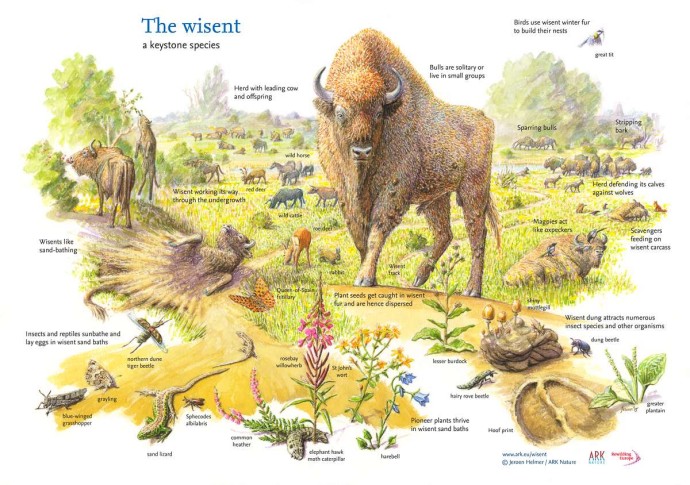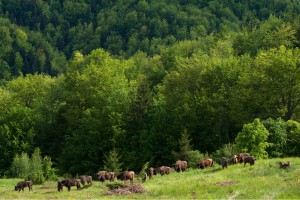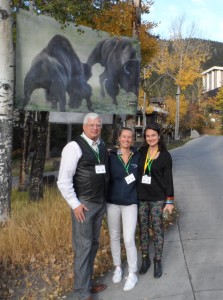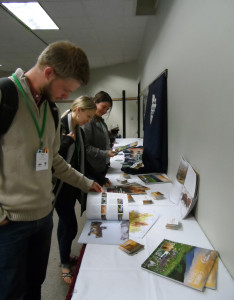I can easily say that for me September this year was the ‘bison month’. At the beginning of this month, I participated at the annual European bison conference in Poland where we discussed the status and progress on the return of Europe’s largest living land mammal. Then, I travelled all the way to Canada to show the North American bison conservationists what we are doing over here in Europe to support our own bison species, and learn from the work done on the American bison. It turns out that there are quite some similarities between our intercontinental stories about these iconic animals.

Europe
Like every year, early September is reserved in my agenda for a trip to Poland. With delight I travel there to participate in the annual conference organized by the European Bison Friends Society that gathers professionals focusing on the conservation of European bison – also known as ‘wisent’. The species was wiped out in the wild in the late 1920’s, and due to very committed conservationists, bison bred in captive conditions were released from the 1950’s onward. European bison is still in the danger zone with the threat of becoming extinct in the wild once again, and we all need to do a lot more to recover them.
Every year a different bison site is hosting the event, this year it took place in Gulochow, some 125 km northeast of Wroclaw, in central-west Poland. As every year, the reunion hit off the first evening when we, bison enthusiasts, met. During the following days, many wisent wisdom passed by: from how GPS equipped bison move around in the landscapes, all the way to specific diseases effecting the species. All stories were told with so much passion, covering every detail accompanied with photos and video. I can honestly say, I felt right at home. Being involved in European bison projects in the Netherlands, I had something to share myself. I presented an overview of nine years of studying bison in the nature area called Kraansvlak, and spoke about two new bison projects in Dutch nature reserves. Having some 30 bison in a small-sized, human-dominated country like The Netherlands, is quite an achievement and I was very keen to share our story.

For several years now, Rewilding Europe and WWF Romania are jointly working on the comeback of the European bison to Romania and from 2016 with financial support of the LIFE Nature programme. Adrian Hagatis and Alexandru Bulacu, from the Southern Carpathians rewilding team shared their impressive story about bison reintroduction and the progress of this rewilding project. Through the LIFE Bison project, the plan is to release at least 100 bison over five years in two release sites. The aim is to create a viable, free-roaming population in Romania. Currently in Europe, the European Bison Pedigree Book recognizes there are only 39 free-ranging bison herds, which in itself is a record since the year 2000. To put even more perspective: at the end of that year only four herds existed counting more than 100 individuals. It is valid to say this project is on its way to make a substantial contribution to the overall European bison population. This year, at the third bison release in three consecutive years, 10 more bison were brought to this lush rewilding site. Romania is now the eight European country where bison roam freely. In addition, there are increasing efforts also in other countries to bring a brighter future for this furry giant.
At the conference, Professor Wanda Olech, chair of European IUCN’s Bison Specialist Group announced that there are now over 6,000 bison in Europe. There is now more space available for the European bison, a species listed as Vulnerable by IUCN, and that enables the increase of wild bison populations. That is a message you can take home with hope and satisfaction as a bison conservationist.
North America

Two weeks later, during my flight to the Rocky Mountains, Canada, I found myself enjoying the astonishing scenery from the airplane looking down at Iceland and Greenland. The beautiful setting of Canadian Banff National Park was the place of the American counterpart of my last meeting – the gathering of the American Bison Society. This bi-annual congress took place for the fifth time, and for the first time in Canada. The vibe was set immediately. Canadians thanked the USA for testing the first four events so that Canadians could now start with the real deal. The room fills with laughter – ready to start.
The meeting was organized by the Wildlife Conservation Society (WCS) and hosted by Keith Aune, chair of the American IUCN Bison Specialist Group, focused on the theme of cultural and social dimensions of restoring bison populations. Rewilding Europe was invited to share its plans and activities about European bison conservation, and to present the Southern Carpathians bison programme that includes direct involvement of local communities. I presented our work so far, and shared experiences with all those people involved in conservation of the American cousin of our bison species.
Comparing American and European bison
Soon I learned that although the American bison (Bison bison) outnumbers his European relative big time, it is still in the danger zone. There are around 300,000 American bison, distributed over both the USA and Canada, purely for the meat production industry. The figure becomes less encouraging when talking about the wild American bison: there are only about 31,000 animals comprising 68 wild herds. There is a tremendous difference with European bison numbers: the largest wild American bison herd counts some 4,000 individuals; that is similar to all free ranging bison in the whole of Europe! To put into historic perspective: a number of approximately 40 million bison roamed North America some 200 years ago…
The good news is that the American bison is listed as Near-Threatened on the IUCN Red List, and studies reveal the species is nowadays at a low risk of extinction. However, this still calls for further actions. It is therefore inspiring to hear about ongoing efforts taking place from Alaska all the way south to Mexico, where over 110 bison are roaming.

Except in-depth discussions about the status of herds, conservation actions, importance of zoos and breeding centres, participants also reflected on human-social aspects related to bison conservation. For someone from a different continent, it truly shed light on the importance of dusting off the recent and relentless history of bison. The connectivity of Canadian First Nations and American Tribes with bison, or ‘buffalo’, is deep and passionate. Also in Europe many people feel a bond with bison, although in many places it takes cave paintings and historical place names to remind us about the bison, as the species has been out of sight for so many years in much of the European landscapes.
Similarities between the European and American stories are abundant. Both species were heavily persecuted by humans in recent history, resulting in the loss of their former vast geographic ranges. Fortunately in both continents, people stood up and made tremendous efforts to save the bison from extinction. Today, we see former conservation actions have made a world of difference since bison numbers increased and more and more people know about them, showing respect and interest in these magnificent creatures.
American and European bison look quite alike, although it is easy to spot clear differences in their build. Since they were almost wiped out completely, genetic diversity is quite low thus both species face similar threats. For American bison there are also issues related to cattle gene introgression. A difference with the European situation is that hardly if at all any meat production takes place so all European bison are considered as being a wild species. Again similar, there are important aspects linked to disease transmission, especially to/from livestock which can have major economic and legal consequences.
Let’s team up!
The journey from Poland to Canada made me realize that on both sides of the Atlantic Ocean, tremendous efforts are helping the bison genus to survive into the 21st century, with many great people and organisations involved working with a lot of passion to achieve this. Still, there are many challenges staring right in the beautiful brown eyes of both American and European bison. With so much common ground, it only seems logic to continue teaming up. There is so much knowledge on both continents, and willingness to push the bison further out of the danger zone to see it thrive our landscapes once again. Let us work together as conservationists, managers, scientists, artists, and individuals to embrace bison, putting them back on their lost tracks where they historically belong.
During the week of the conference, students from Blackfeet Community Collage, Randal Cruz and Teela Young Running Crane, created this video that was showcasted at the events final night. Take a look.
